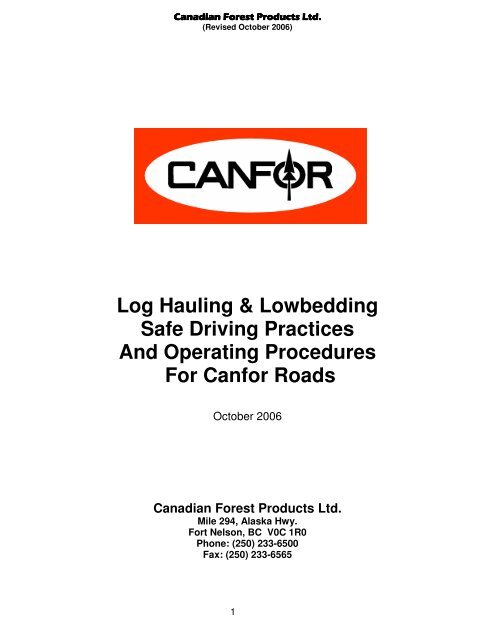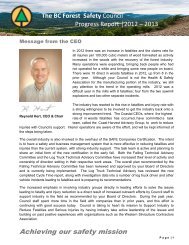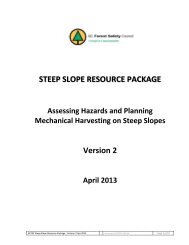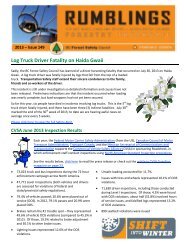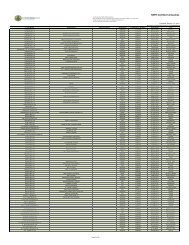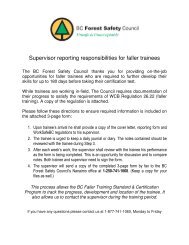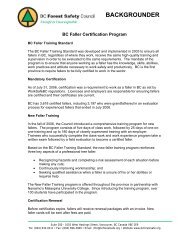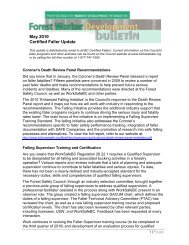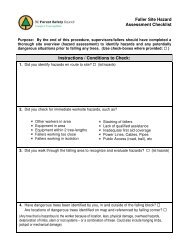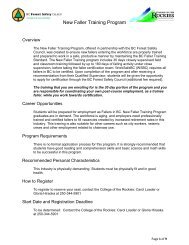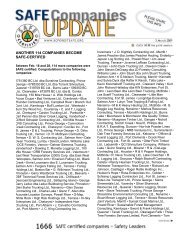Log Hauling & Lowbedding Safe Driving Practices And Operating ...
Log Hauling & Lowbedding Safe Driving Practices And Operating ...
Log Hauling & Lowbedding Safe Driving Practices And Operating ...
You also want an ePaper? Increase the reach of your titles
YUMPU automatically turns print PDFs into web optimized ePapers that Google loves.
(Revised October 2006)<br />
<strong>Log</strong> <strong>Hauling</strong> & <strong>Lowbedding</strong><br />
<strong>Safe</strong> <strong>Driving</strong> <strong>Practices</strong><br />
<strong>And</strong> <strong>Operating</strong> Procedures<br />
For Canfor Roads<br />
October 2006<br />
Canadian Forest Products Ltd.<br />
Mile 294, Alaska Hwy.<br />
Fort Nelson, BC V0C 1R0<br />
Phone: (250) 233-6500<br />
Fax: (250) 233-6565<br />
1
(Revised October 2006)<br />
TABLE OF CONTENTS<br />
SAFETY POLICY STATEMENT ..................................................................................3<br />
SUBSTANCE ABUSE POLICY & PROCEDURES ......................................................3<br />
DRIVER QUALIFICATIONS.........................................................................................4<br />
HOURS OF SERVICE..................................................................................................5<br />
LOGGING TRUCK SIGNAGE REQUIREMENTS ........................................................6<br />
WORKSAFE BC REQUIREMENTS - LOGGING TRUCK BULLBOARDS...................7<br />
BC FOREST SAFETY COUNCIL RULES OF THE ROAD ..........................................8<br />
SAFE DRIVING PRACTICES AND PROCEDURES....................................................9<br />
RADIO USAGE ............................................................................................................11<br />
Radio Frequencies....................................................................................................13<br />
SAFETY EQUIPMENT.................................................................................................13<br />
SAFETY INSPECTIONS..............................................................................................13<br />
LOAD SECURITY REQUIREMENTS FOR LOG HAULING AND LOWBEDDING.......14<br />
LOAD WEIGHTS FOR LOG HAULING ....................................................................14<br />
LOADING SPECIFICATIONS FOR LOG HAULING.................................................15<br />
MARKING SPECIFICATIONS......................................................................................17<br />
LOG YARD POLICY.....................................................................................................17<br />
REPORTING OF INCIDENTS......................................................................................18<br />
VIOLATIONS/DISCIPLINE PROCESS ........................................................................18<br />
TRUCK AUDITS...........................................................................................................20<br />
Contractors “<strong>Log</strong> Truck Audits” process: ..................................................................20<br />
Canfor Staff “<strong>Log</strong> Truck Audits” process:..................................................................20<br />
Completing the Truck Audit Form: ............................................................................21<br />
Submission, Review and Presentation of Truck Audit Information: ..........................21<br />
EXPECTATIONS ON: Actions for Non-compliance:.................................................22<br />
EMERGENCY REFERENCE SHEETS........................................................................23<br />
GENERAL ................................................................................................................23<br />
ENVIRONMENTAL (i.e.: landslide)...........................................................................23<br />
EQUIPMENT FIRE ...................................................................................................23<br />
FOREST FIRES........................................................................................................23<br />
MEDICAL AID...........................................................................................................23<br />
VEHICLE ACCIDENT...............................................................................................23<br />
REPORTING INFORMATION FOR VEHICLE ACCIDENT ......................................24<br />
SPILLS INTO WATER OR LARGE (>100 LITRES) SPILLS.....................................24<br />
EMERGENCY RESPONSE CONTACTS – FORT NELSON WOODLANDS...............25<br />
Emergency Aircraft Evacuation Contacts .................................................................26<br />
Emergency Service Response Contacts ..................................................................26<br />
Emergency First Aid Personnel/ Services.................................................................27<br />
DISPATCH INFORMATION FOR HOSPITAL / AIR AMBULANCE ..........................28<br />
FORMS:<br />
Truck Audit<br />
Truck Driver – Sign Off – stays in book<br />
Truck Driver – Sign Off - retained by Contractor and faxed to Canfor Admin<br />
Trucking Registration Form – retained by Contractor and faxed to Canfor Admin<br />
Truck <strong>Safe</strong>ty Inspection Check List – retained by Contractor and faxed to Canfor<br />
Admin<br />
2
SAFETY POLICY STATEMENT<br />
(Revised October 2006)<br />
Canadian Forest Products Ltd., Fort Nelson Woodlands is committed to promoting<br />
attitudes and work conditions that ensure a safe, healthy and productive work environment<br />
throughout all areas of operations. The management team, staff and all contractors are<br />
responsible for carrying out the programs and day to day activities to meet this objective.<br />
It is Canfor’s expectation that every employee and contractor will work cooperatively in<br />
preventing accidents and correcting attitudes or conditions that may lead to an unsafe and<br />
unproductive work environment.<br />
Introduction<br />
The purpose of these safety procedures is to enhance the Worker’s Compensation Board<br />
(WCB), Industrial Health and <strong>Safe</strong>ty Regulations. These safety procedures are<br />
supplementary to the WCB Regulations and do not replace or override those regulations.<br />
This document will be updated annually by CANFOR.<br />
The following safety policies and procedures have been endorsed by CANFOR’s Fort<br />
Nelson Operations that all contractors and road users will ensure the drivers of their trucks<br />
and their sub-contracted trucks delivering logs (or other products) to CANFOR mills<br />
understand and follow these safety policies and procedures. CANFOR is committed to safe<br />
log transportation.<br />
Contractors will be required to review and sign off this document with their log truck drivers<br />
and any sub-contract trucks annually, or upon the hiring of. any new drivers or trucks. The<br />
contractor must submit a copy of the signed document, prior to the commencement<br />
of hauling.<br />
Trucks showing up to a CANFOR scale site without a completed sign off of the <strong>Safe</strong><br />
<strong>Driving</strong> <strong>Practices</strong> and <strong>Operating</strong> Procedures, will not be unloaded.<br />
SUBSTANCE ABUSE POLICY & PROCEDURES<br />
Policy<br />
This policy is applicable to all employees, contractors, contractor employees and<br />
any other individuals providing services to Canfor.<br />
The possession, use, sale or distribution of alcoholic beverages, illegal drugs or<br />
restricted drugs without a prescription on Canfor Fort Nelson Operations’ premises<br />
at any time is prohibited.<br />
No one shall engage in any work for Canfor Fort Nelson Operations in an impaired or<br />
intoxicated condition or under the influence of alcohol or drugs.<br />
No driver shall enter or be permitted to remain on the premises of any Canfor place<br />
of operation or property while his/her ability to work is affected by alcohol, drugs or<br />
3
(Revised October 2006)<br />
other substances. Such an infraction will be subject to Canfor’s or the Contractor’s<br />
substance abuse policies and the RCMP will be contacted for their involvement in<br />
the matter.<br />
Enforcement<br />
Any person who violates this policy will be subject to disciplinary action, up to and including<br />
discharge.<br />
If Canfor or its contractors have reasonable grounds to believe that an employee’s<br />
behaviour or work performance may be adversely affected or that a safety risk is raised as<br />
a result of use of drugs or alcohol on or off duty, the employee will be directed to leave the<br />
Company property immediately with safe transportation provided and may be subject to<br />
testing for the presence of drugs and / or alcohol.<br />
DRIVER QUALIFICATIONS<br />
A detailed list of required qualifications and proof of status is contained on the trucking<br />
registration form included in this book. These documents must be provided to Canfor prior<br />
to the commencement of work. All Contractors are responsible for ensuring that drivers<br />
show knowledge and understanding of Canfor’s <strong>Safe</strong> <strong>Driving</strong> <strong>Practices</strong> and <strong>Operating</strong><br />
Procedures for Canfor Roads.<br />
<strong>Log</strong>ging truck drivers must possess a valid driver’s license as required by the Motor Vehicle<br />
Branch in BC.<br />
Drivers must possess an understanding of the WCB Occupational Health and <strong>Safe</strong>ty<br />
Regulations applicable to their work and must also possess an understanding of the Motor<br />
Vehicle Act & Regulations, Commercial Transport Act & Regulations and the Motor Carrier<br />
Act. Drivers must also comply with Canfor’s Forest Management System (FMS) (see<br />
information found in this book on page). Trucks and trailers must be equipped and<br />
maintained to meet these Regulations.<br />
Canfor recommends all truck drivers obtain a valid First Aid Ticket, Level 1 with the<br />
Transportation Endorsement.<br />
It is imperative that all drivers have a clear understanding of the English language to ensure<br />
safety to all. English is the language used on Canfor roads and property.<br />
All commercial drivers on Canfor roads should be familiar with the information published by<br />
ICBC, Commercial Vehicle Service, Booklets #1 to 6:<br />
1) Information for Commercial Carriers<br />
2) Cargo Security<br />
3) Commercial Vehicle Inspection Program<br />
4) Commercial Vehicle Maintenance Program<br />
5) National Cargo Security<br />
6) National Security Code<br />
4
(Revised October 2006)<br />
These guides are available at the government weigh scales and are also available by<br />
accessing internet website: www.th.gov.bc.ca<br />
All drivers are required to obtain from the ICBC weigh scales an oversize term permit to<br />
allow for empty over-width trailers up to 3.2 m wide to travel on provincial highways and a<br />
highway crossing permit for loaded over-width trailers to cross provincial highways.<br />
Drivers should be knowledgeable of the Town of Fort Nelson Traffic Control Bylaws and<br />
parking requirements.<br />
HOURS OF SERVICE<br />
You may be aware that Transport Canada, after considering medical evidence relating<br />
fatigue to road safety, has amended the regulation governing the commercial vehicle<br />
hours of service for commercial truck drivers, effective Jan 1st/07. This revised<br />
regulation can be found at :<br />
http://canadagazette.gc.ca/partII/2005/20051116/html/sor313-e.html<br />
This amended regulation includes a 70 hour weekly cap and re-setting provisions<br />
geared towards inter-provincial type of long hauling. At the same time the Province<br />
indicated that the BC <strong>Log</strong> <strong>Hauling</strong> Exemption (allowing 15 hours/day as long as the oneway<br />
trip did not exceed 160 Km) would be cancelled.<br />
COFI and the Central Interior <strong>Log</strong>ging Association collaborated on a counter-proposal<br />
that was accepted by the Province. As a result, it is expected that there will be a BC <strong>Log</strong><br />
<strong>Hauling</strong> Variance effective Jan 1st/07 that will include the following:<br />
- To use the variance, drivers must keep a log book for hours worked.<br />
- Daily cap of 13 hours on driving time.<br />
- Daily working hours cap of 15 hours per day (non driving time includes fueling, or any<br />
working time outside of the cab).<br />
- Minimum of 9 hours per day of continuous non-working time.<br />
- Weekly driving time cap of 65 hours.<br />
- Weekly working time cap of 80 hours (not 75 hours, the extra time allows owneroperators<br />
to do maintenance, chase parts, etc on week-ends).<br />
- there is a new onus on schedulers (fleet operators) to not create work schedules that<br />
put drivers out of compliance with the caps on hours.<br />
In all cases, if drivers do not keep a log book, they will by default be operating<br />
under the Federal regulation which is quite different from the BC log hauling<br />
variance described above. Canfor will be auditing truck drivers to confirm log<br />
books are being maintained.<br />
5
(Revised October 2006)<br />
LOGGING TRUCK SIGNAGE REQUIREMENTS<br />
Mandatory <strong>Log</strong>ging Truck Signage is now in place for all trucks delivering to the Canfor<br />
Mills in Fort Nelson. See drawing below for placement of signage.<br />
All trucks are required to have a numbered plate provided by Canfor at a cost of $20 per<br />
plate. This fee will be charged to the logging contractor and will be refunded upon return<br />
of the plate to Canfor in a usable condition.<br />
<strong>Log</strong>ging Trucks will not be weighed at the Canfor scales unless this plate is in place.<br />
6
(Revised October 2006)<br />
WORKSAFE BC REQUIREMENTS - LOGGING TRUCK BULLBOARDS<br />
All logging trucks that deliver wood to the Tackama and Polarboard <strong>Log</strong> Yards are<br />
required to be in compliance with the following Worksafe BC standards regarding<br />
logging truck bullboards:<br />
26.65 Bullboards<br />
(1) for the protection of the driver, each logging truck must have, at the back of the cab,<br />
a substantial barrier that<br />
(a) is at least 15 cm (6 in) higher than the cab, and<br />
(b) is at least as wide as the cab.<br />
(2) the barrier at the back of the cab of a self-loading logging truck may be less than the<br />
height specified in subsection (1) but must not be less than the cab height.<br />
[Amended by B.C. Reg. 253/2001, effective January 28, 2002.]<br />
[Amended by B.C. Reg 73/2005, effective February 25, 2005.]<br />
(3) for the purposes of subsection (1), the barrier must be capable of withstanding a<br />
horizontal forward static load equal to 40% of the weight of the cargo being<br />
transported that may shift and contact the barrier, with this load uniformly distributed<br />
over the entire barrier.<br />
(4) the barrier of the logging truck must be<br />
(a) designed, constructed and maintained so that it has no aperture large enough to<br />
permit any item of cargo to pass through it, and<br />
(b) installed in a manner acceptable to the Board to ensure that the rated capacity of<br />
the barrier is not diminished.<br />
(5) The barrier must be<br />
(a) permanently marked with<br />
(i) the name and address of its manufacturer,<br />
(ii) the model number or serial number of the barrier, and<br />
(iii) its rated capacity in terms of the cargo weight that may be transported<br />
in compliance with this section, or<br />
(b) Identified by carrying in the logging truck a copy of a letter that<br />
(i) accurately describes the barrier,<br />
(ii) certifies the model number or serial number of the barrier and its rated<br />
capacity in terms of the cargo weight it can carry, and<br />
(iii) has been signed by the manufacturer or a professional engineer.<br />
[Amended by B.C. Reg. 18/2006, effective May 17, 2006.]<br />
7
(Revised October 2006)<br />
BC FOREST SAFETY COUNCIL RULES OF THE ROAD<br />
All Drivers are to use the following rules of the road that have been developed by the<br />
BC Forest <strong>Safe</strong>ty Council for the province of BC as a guide to improve road safety.<br />
8
(Revised October 2006)<br />
SAFE DRIVING PRACTICES AND PROCEDURES<br />
As the driver of the vehicle, you MUST DRIVE SAFELY and assume responsibility for the<br />
safe operation of your vehicle and load while driving on roads under permit to Canadian<br />
Forest Products Ltd. and while driving on provincial and municipal roads. Every one’s cooperation<br />
and good judgment is required to reduce the number of incidents and accidents<br />
on our roads.<br />
The following <strong>Safe</strong> Work Procedures must be adhered to:<br />
1. Drivers of all industrial vehicles must complete and record daily pre-trip inspections.<br />
2. Seat belts MUST be worn at all times.<br />
3. No unauthorized person should be in the drivers compartment except:<br />
• In the case of an emergency, or<br />
• One authorized passenger such as a trainee or supervisor.<br />
4. All lights, MUST be turned on when the vehicle is in motion, day or night. Turn off<br />
headlights at night when parked to clear loaded traffic.<br />
5. Drivers MUST obey all road signs. Typically Canfor’s road signs are yellow<br />
background and black lettering, but some temporary signs (not in yellow) may be<br />
installed in the case of a newly identified hazard.<br />
6. The maximum speed for log haul trucks and other industrial vehicles on Canfor<br />
roads is 80 km/hr (empty), 60 km/hr (loaded) on mainline roads or as otherwise<br />
posted. Slower speeds are required on branch and spur roads based on the road<br />
design. (30 km/hr empty and 25 km/hr loaded for log hauling, lowbed and other<br />
industrial trucks.<br />
7. Drivers exceeding the posted speed, or not driving to road conditions, sometimes<br />
cause loads to become unstable. On early winter roads, when the frost heaves are<br />
common across the muskeg, drivers are recommended to slow down. Loaded<br />
aspen logs 2.7 and 5.3 m in length can work out from the bunks due to the constant<br />
twisting of the trailer across the frost heaves. Excessive speed is a factor in this<br />
problem.<br />
8. Drivers must SLOW DOWN on narrow road sections or when approaching blind<br />
corners, hills and intersections. Always slow down when approaching a bridge.<br />
Always find a pullout well in advance of clearing loaded vehicles. Trucks must stop<br />
at all public roadways.<br />
9. Drivers must recognize and slow down for changing road conditions due to changing<br />
weather. If the driver judges it unsafe to continue, then park the truck and trailer in a<br />
safe location.<br />
9
(Revised October 2006)<br />
10. Truckers must stop, step out of the vehicle and check loads at Canfor’s identified<br />
mandatory wrapper check stations or more often as conditions require. Hardhat and<br />
high vis vest are to be worn by the driver.<br />
11. All loaded vehicles (pickups, logging trucks, lowbeds and industrial vehicles) have<br />
the right of way except for emergency vehicles or maintenance equipment.<br />
12. All "EMPTY" vehicles (pickups, logging trucks, lowbeds and industrial vehicles)<br />
MUST YIELD THE RIGHT OF WAY TO LOADED VEHICLES.<br />
13. Tire chains are permitted on hills to aid empty and loaded trucks as required. Tire<br />
chains are not permitted on flat road sections.<br />
Passing, Following, <strong>And</strong> Right Of Way<br />
NEVER pass a loaded logging truck or industrial vehicle without notifying them on the radio<br />
and receiving the “OK” from driver.<br />
Loaded vehicles are responsible for slowing down, providing room and advising “OK” signal<br />
to vehicle requesting to pass.<br />
Keep a safe distance when traveling behind another vehicle. Be particularly careful when<br />
snow or dust is obstructing your view.<br />
Bridges<br />
Ice bridge crossings are regulated at a speed of 15 km/hr maximum or otherwise posted –<br />
convoys with loads should cross at minimum 100m intervals. Ice bridges bend under the<br />
weight of each load, that creates a wave under the ice. If you are travelling too fast, the wave<br />
will not have time to disperse when you approach the opposite shore or hidden sand bars and<br />
may “blow up” the ice in front of you. Ice bridges are particularly vulnerable for the first three<br />
weeks following construction. Reduce your speed to 5 km/hr during these periods. Obey<br />
the posted speed sign at all bridges, everyone’s job depends upon these bridges!<br />
For all other bridges maximum speed 30km/hr.<br />
Stopping<br />
Vehicles MUST NOT be parked on the road unless the stop is made at a safe passing<br />
point. In the event of an emergency, take the necessary steps to warn all traffic (flares,<br />
flag persons, radio warnings and signs).<br />
Damage to Roads or Bridges<br />
The cost of repairs from damage to any road or bridge will be charged back to the owner of<br />
the truck, the Contractor or the Road Use Agreement Holder.<br />
10
On-Block Procedures<br />
(Revised October 2006)<br />
Use only the posted radio frequency for the block.<br />
Drivers must remain either in the cab of the vehicle or stand 13m in front of the truck<br />
in clear view of the loader operator at all times while the truck is being loaded. Notify<br />
the loader operator before leaving the truck and upon returning into the truck.<br />
After loading is completed, a loaded log haul truck may be moved a short distance (up to<br />
500 m) without wrappers or binders, provided that no workers are endangered, and there<br />
is a minimal chance the load will shift (i.e.: Do not travel up or down steep grades or on<br />
rough roads).<br />
Cell Phone Use<br />
Cellular telephones have been common and invaluable in forestry operations. Insurance<br />
Corporation of British Columbia (ICBC) studies have found that listening and responding to<br />
relatively complex messages while continuing to drive, significantly degrades driving<br />
performance, especially during complex driving maneuvers.<br />
On Canfor radio controlled roads, drivers’ attention should be focused on following the<br />
traffic using both the radio and visual signs to ensure safe use of the road. Canfor strongly<br />
suggests all drivers to reduce the risk of accidents, incidents and near misses by pulling<br />
into the first available turnout to complete calling activities using cellular phones. Continue<br />
to monitor traffic on the road.<br />
Procedures for Blocking /Re-routing Traffic<br />
It is imperative that signs and traffic controls are in place during the cleaning of all spilled<br />
loads or any abnormal activity that may block Canfor roads. All signs and traffic controllers<br />
must be in clear view and away from any blind hills and corners that may be hazardous.<br />
RADIO USAGE<br />
Breakdown in radio communications is a leading cause of accidents, so please use<br />
your radio appropriately. Mistakes are made, so be alert, always drive defensively.<br />
Radio frequency usage is coordinated by Canadian Forest Products Ltd. Always<br />
remember that roads are open to the general public and periodically, vehicles without<br />
radio's get onto our road system. Drive by the road, not by the radio alone.<br />
If your radio fails to transmit, stop and arrange to follow another driver, with him calling for<br />
your vehicle.<br />
A copy of the radio channels and road frequency map should be carried and be readily<br />
available. An updated list of radio frequencies used for Canfor operations is distributed at<br />
the beginning of each logging season.<br />
11
(Revised October 2006)<br />
Use only approved frequencies assigned to an area or road. At the entrance to each road,<br />
a sign will indicate the correct radio frequency for that road. If there is a discrepancy<br />
between maps or documentation, always follow the information posted on the sign at<br />
the road entrance.<br />
All vehicles operated by the Contractors and their employees and subcontractors are<br />
required to have a functioning radio capable of monitoring and transmitting on all of the<br />
radio frequencies required by Canfor. Contractors must instruct employees and<br />
subcontractors in the proper use of these radios.<br />
Calling Kilometers<br />
• Observe posted radio frequency at the beginning of each road and kilometer signs<br />
posted along the roads.<br />
• Lock onto posted frequency, no scanning.<br />
• Always turn OFF your AM/FM radio and stereo.<br />
• Call to announce specific intentions such as leaving a road, turning onto a different<br />
road, switching frequencies, etc.<br />
• All vehicles should be calling Loaded or Empty first, then vehicle type if not a logging<br />
haul truck (i.e.: wide load, lowbed, fuel truck, pickup, service truck) kilometer and road<br />
name.<br />
• Escort vehicles must speak in a clear and concise manner.<br />
LOADED – all vehicles headed towards the mill<br />
• LOADED must call every posted kilometer sign,<br />
EMPTY – all vehicles headed away from the mill<br />
• EMPTY vehicles should not call kilometer signs except where identified by a call empty<br />
sign accompanying the kilometer sign.<br />
• EMPTY vehicles must call when entering or leaving a road, at a bridge, a blind corner,<br />
major hill or dip, winding road section or when uncertain about the oncoming traffic.<br />
• All "EMPTY" vehicles must yield the right of way to loaded vehicles.<br />
If you are unsure of the location of oncoming traffic, find a wide spot, pull over, proceed<br />
only when you are satisfied that you know what traffic is in your vicinity.<br />
Please follow proper procedures – be polite, be specific and timely in your communication.<br />
Radio use is restricted to calling kilometer location and important messages. If you<br />
must have a conversation, pull off the road in a safe spot and use a channel that will<br />
not interfere with the road use. “Idle chatter” is unnecessary and dangerous to<br />
yourself and other road users.<br />
Use of profane/obscene language is unacceptable. The violator may be subject to action<br />
being taken by Transport Canada.<br />
12
Radio Frequencies<br />
(Revised October 2006)<br />
All logging trucks must have the frequencies listed below programmed in their radios. The<br />
road name and the approved road radio frequency will be posted at the beginning of every<br />
road. Contractors may use their own licensed frequencies for in-block loading and<br />
harvesting operations.<br />
When loading on a mainline road occurs, Canfor supervisors will approve the radio<br />
frequency and procedures.<br />
Frequency Name Frequency<br />
FNFI ROAD 151.115<br />
TACKAMA ROAD 152.030<br />
TACKAMA YARD 153.410<br />
POLAR ROAD 151.265<br />
POLAR YARD 151.835<br />
SLOCAN ROAD 151.355<br />
MUSKWA 151.895<br />
LADD 1 154.100<br />
LADD 2 158.940<br />
LADD 3 154.325<br />
CCMC 153.170<br />
ENCANA 2 152.060<br />
SAFETY EQUIPMENT<br />
All trucks must carry safety equipment as identified on Canfor’s Truck <strong>Safe</strong>ty Checklist,<br />
located at the back of this book.<br />
Personal Protective Equipment must be worn whenever outside of vehicle (i.e. hi-vis blaze<br />
orange hard hat, hi-vis vest, approved footwear, hearing and eye protection, PPE is to meet<br />
or exceed CSA or ANSI standards, as required).<br />
SAFETY INSPECTIONS<br />
All contractors will complete and document a safety inspection of trucks prior to employing<br />
trucks.<br />
All trucks and trailers must have an approved Ministry of Transportation <strong>Safe</strong>ty Inspection<br />
Report before registration with Canfor. In addition, all trucks and trailers may be subject to<br />
random, spot inspections by Canfor appointed inspectors.<br />
Canfor reserves the right to suspend any truck or trailer, without compensation for lost<br />
economic opportunity that fails to pass an inspection. Trucks and trailers will be allowed to<br />
commence operations when the Contractor and Canfor are satisfied that all necessary<br />
repairs are completed.<br />
13
(Revised October 2006)<br />
LOAD SECURITY REQUIREMENTS FOR LOG HAULING AND<br />
LOWBEDDING<br />
All commercial drivers on Canfor roads are to follow the load security requirements in the<br />
Motor Vehicle Act. For information on securing the load, number of tie downs required,<br />
strength of tie downs please review the information published by ICBC, Commercial Vehicle<br />
Service in Booklet #2: Cargo Securement, 2005. This is a handy guide and it is available<br />
at the government weigh scales.<br />
LOAD WEIGHTS FOR LOG HAULING<br />
No payment will be made for any weight exceeding the approved weights.<br />
Off-Highway Loads<br />
The maximum net weight of any 6 axle off-highway load to Canfor’s Tackama or<br />
PolarBoard scales is not to exceed 58,000 kg (58 tonnes).<br />
The maximum net weight of any 7 axle off-highway load to Canfor’s Tackama or<br />
PolarBoard scales is not to exceed 60,000 kg (60 tonnes).<br />
The maximum net weight of any 8 axle off-highway load to Canfor’s Tackama or<br />
PolarBoard scales is not to exceed 63,000 kg (63 tonnes).<br />
Highway Loads- Winter (Nov 1 to Mar 31)<br />
The maximum GVW of any 6 axle highway load to Canfor’s Tackama or PolarBoard scales<br />
is not to exceed 49,000 kg (49 tonnes).<br />
The maximum GVW of any 7 axle highway load to Canfor’s Tackama or PolarBoard scales<br />
is not to exceed 57,800 kg (57.8 tonnes).<br />
The maximum GVW of any 8 axle highway load to Canfor’s Tackama or PolarBoard scales<br />
is not to exceed 63,500 kg (63.5 tonnes).<br />
Highway Loads- Summer<br />
The maximum GVW of any 6 axle highway load to Canfor’s Tackama or PolarBoard scales<br />
is not to exceed 48,000 kg (48 tonnes).<br />
The maximum GVW of any 7 axle highway load to Canfor’s Tackama or PolarBoard scales<br />
is not to exceed 56,800 kg (56.8 tonnes).<br />
The maximum GVW of any 8 axle highway load to Canfor’s Tackama or PolarBoard scales<br />
is not to exceed 63,500 kg (63.5 tonnes).<br />
14
(Revised October 2006)<br />
LOADING SPECIFICATIONS FOR LOG HAULING<br />
The truck driver will ensure that his truck is loaded in compliance with Canfor’s <strong>Log</strong> Sorting<br />
and Loading Specifications and in compliance with W.C.B. Regulations. Drivers are<br />
accountable for their loads and must take adequate caution and care in loading, securing<br />
and transporting logs to ensure no logs fall from the trailer.<br />
No mixed lengths and / or species are to be loaded within one trailer bunk.<br />
No mixed sorts in a B-train or tridem trailer are permitted, (unless approved by a Canfor<br />
Forestry Supervisor for clean up). Clean-up mixed loads require one load slip for each sort<br />
on the trailer.<br />
The loader operator and the trucker will ensure that Company load slips are completed<br />
correctly prior to leaving the loading area. Failure to do so may result in no payment for the<br />
load.<br />
All loads must be secured to prevent any movement of the load. <strong>Log</strong>s must not exceed 3<br />
m from the rear of the trailer.<br />
<strong>Log</strong>s must be suitably crowned to allow straps or cables to contact as many logs as<br />
possible. At the bunk stakes, no logs should be more than one half their height above the<br />
stake, and the center logs should taper upwards to a smooth rounded crown. All logs must<br />
be in a secure lay, with no danger of falling from the load during installation or removal of<br />
wrappers. Refer to the photographs in this booklet or at the Canfor weigh scales for<br />
examples of acceptable crowning of loads.<br />
Loads arriving at the Canfor weigh scales judged to be unacceptably over-height, will be<br />
parked and a Canfor supervisor will be notified.<br />
All loads must be secured by wrappers and / or cables and cinches in accordance with the<br />
WCB Industrial Health & <strong>Safe</strong>ty Regulations and the Motor Vehicle Act Regulations.<br />
Special Requirements for 2.7 m Aspen OSB <strong>Log</strong>s<br />
Aspen logs have the most risk of falling from the trailer. The smooth bark and frost on the<br />
bark in winter conditions can cause loads on the last bunk to become unstable, and logs to<br />
fall out.<br />
Loader operators should alternate butts and tops on the bunks to distribute the butt flares<br />
and small logs as much as possible. Also, they should remove voids near and at the top of<br />
the load as much as possible to ensure all logs contact stakes, wrappers and other logs.<br />
No logs with excessive crook, sweep or deformity should be loaded on the rear most bunk<br />
of the trailer.<br />
Drivers are now required to install a third wrapper or steel cable and cinch around<br />
the middle of the last bunk of 2.7 m aspen OSB logs on each trailer.<br />
15
Spacing of Bunk Stakes for Trailers<br />
(Revised October 2006)<br />
Canfor has determined that inter bunk spacing of 48 inches (1.3 m) for bunks 2-3, 5-6, and<br />
8-9 on tridem trailers and on bunks 2-3, 6-7 and 10-11 on B-train trailers reduces that<br />
amount of damage for log unloading at log yards. Note the exact spacing is 48 inches from<br />
the inside of the vertical stakes and not from the inside or the center of the bunks or<br />
pockets. Diagrams for bunk stake spacing are available from Canfor Woodlands.<br />
Photograph of an Acceptable Aspen 2.7 m OSB Loaded Trailer<br />
16
MARKING SPECIFICATIONS<br />
(Revised October 2006)<br />
All trailer loads require painted timber marks on the ends of the two front corners and both<br />
sides of the load for a total of four paint marks. All detachable trailer loads must be marked in<br />
the same manner. Drivers must ensure that timber marks are applied before leaving the cutblock.<br />
LOG YARD POLICY<br />
Canadian Forest Products Ltd. is determined to promote a safe work environment. All<br />
employees and contractors will follow the following policies and regulations while on either<br />
Mill Site:<br />
All log yard equipment has the right-of-way in the <strong>Log</strong> Yard.<br />
Maximum Speed Limit while in the <strong>Log</strong> Yard is 20 km/hr.<br />
All truck traffic must come to a complete stop before proceeding onto the Scale<br />
Deck, and proceed at a speed not exceeding 5 km/hr.<br />
Truck Driver must report the following information to the Stacker or Material Handler<br />
Operator as required via radio: Truck #, Load # and Sort #.<br />
Hard hats, high visibility vests, and approved footwear must be worn at all times when<br />
outside of equipment and trucks.<br />
All truck drivers must tag each load and must ensure each tag is secured with the stapler<br />
provided.<br />
If the driver is outside of the logging truck during the unloading procedure, he/she must<br />
stand no less than 13 meters in front of the logging truck in clear view of the loader<br />
operator, maintaining eye contact at all times while the load is being removed. This<br />
procedure applies to the trainees.<br />
The truck driver may remove all load wrappers and binders provided the driver and no other<br />
workers are in danger from falling logs. If there is a danger from falling logs, the driver<br />
must not remove wrappers until the loader has restrained the load. The truck may be<br />
required to wait until all other trucks in the yard are off-loaded first.<br />
For trucks to move safely within the log yard and receive direction from the loaders, all<br />
trucks must have the required log yard radio frequencies as outlined in this hand book.<br />
Any damage done to equipment in the mill-yard must be reported immediately to the <strong>Log</strong><br />
Yard Supervisor before leaving the yard and an accident / incident damage report<br />
completed. Failure to report the damage immediately, may result in rejection of the claim.<br />
17
REPORTING OF INCIDENTS<br />
(Revised October 2006)<br />
Each Contractor will be responsible for enforcing the safe driving practices and rules of the<br />
road for employees and subcontractors under their direct control.<br />
ACCIDENT/INCIDENT INVESTIGATIONS<br />
It is mandatory that all Accidents/Incidents be investigated to determine the cause and to<br />
identify actions to prevent similar accidents/incidents in the future.<br />
Truck Drivers must report all Accidents/Incidents immediately to the Canfor Road <strong>Safe</strong>ty<br />
Hotline (500-1572) and their <strong>Log</strong>ging Contractor.<br />
Depending on the severity of the accident/incident, the investigation report will be<br />
completed by the contractor and submitted to Canfor within 24 hours or Canfor will<br />
attend the accident and complete the accident/incident investigation.<br />
NEAR MISS REPORTING<br />
Near miss reporting books are available from your <strong>Log</strong>ging Contractor or at the Canfor<br />
Scales. These can be submitted to your <strong>Log</strong>ging Contractor or dropped off at the Trucker<br />
Suggestion Box located at the Canfor Scales.<br />
NEW THIS YEAR: CANFOR ROAD SAFETY HOTLINE (500-1572)<br />
Issues that need immediate attention can be reported to the Canfor Road <strong>Safe</strong>ty<br />
Hotline (500-1572).<br />
In case of a fatality or serious injury, absolutely nothing is to be moved. The accident<br />
scene should be secured immediately and must be protected from any change until a full<br />
investigation is completed.<br />
VIOLATIONS/DISCIPLINE PROCESS<br />
Any actions, which seriously jeopardize the safety of others, may result in immediate<br />
termination or other disciplinary action deemed appropriate by Canadian Forest<br />
Products Ltd., including a permanent loss of driving privileges.<br />
The Progressive Discipline Procedure is structured with the following elements:<br />
1. Verbal Warning<br />
2. Written Warning<br />
3. Short Term Suspension (1 day)<br />
4. Long Term Suspension (3 days)<br />
5. Discharge<br />
1. Verbal Warning<br />
A supervisor will issue a verbal warning as a first step when driver conduct in question<br />
is a minor misdemeanor. For example, if a driver fails to observe a relatively minor<br />
policy a verbal warning may be appropriate. The purpose of this warning is to ensure<br />
18
(Revised October 2006)<br />
that the driver is spoken to and is made clear that any repetition of the conduct will<br />
result in greater discipline. In the absence of a verbal warning, a driver may be led to<br />
believe that his/her conduct is acceptable. The verbal warning will be documented and<br />
enforced for one year. The driver will also be given a copy of the warning.<br />
2. Written Warnings<br />
A written warning may or may not be preceded by a verbal warning, depending on the<br />
seriousness of the misconduct. For example, a written warning may be appropriate if<br />
one or more verbal warnings have proven ineffective to correct employee misconduct.<br />
Written warnings will be kept on file for a two-year period.<br />
3. Short Term Suspension<br />
A short-term suspension of one day may be imposed for more serious offenses (i.e.<br />
deliberate failure to follow procedures) or where a verbal or written warning has not<br />
succeeded in correcting less serious forms of misconduct. The purpose of the shortterm<br />
suspension is making the driver acutely aware that the company has a serious<br />
concern about his/her behavior that may result in further, more serious disciplinary<br />
action, including suspension for the remainder of the logging season.<br />
4. Long Term Suspension<br />
A long-term suspension of three days will be issued when lesser forms of discipline<br />
have failed to bring about a change in the driver’s conduct or where the misconduct is<br />
so serious as to justify a very serious suspension (i.e. on the job substance abuse,<br />
gross negligence, gross disregard for following policies, etc.). Any long term suspension<br />
should make it clear to the driver that his/her driving privileges on Canfor roads are in<br />
jeopardy and if the conduct is not corrected his/her employment may be terminated.<br />
5. Discharge<br />
Discharge will result after the above forms of discipline have not corrected a driver’s<br />
misconduct or where an offense is so serious that it may justify immediate termination of<br />
driving privileges. Violations for which a driver may be suspended or discharged include<br />
but are not limited to:<br />
• Possession of alcohol or narcotics while on a Canfor worksite<br />
• Fighting on a Canfor worksite<br />
• <strong>Driving</strong> while under the influence of alcohol or illegal drugs<br />
• Deliberately disregarding safety policies/procedures and/or practices<br />
thereby directly endangering themselves or others<br />
• Falsifying or tampering records or reports<br />
19
(Revised October 2006)<br />
Depending on the amount of time that has elapsed between incidents and the severity of<br />
each incident leading to corrective action, as well as the steps the driver has taken to<br />
correct the problem, the counseling, written warning and suspension steps contemplated<br />
above may be repeated or bypassed. All formal corrective action documentation will be<br />
included in the drivers file and a copy will be given to the driver and the contractor they are<br />
hauling for. As well, improvements in performance and positive action taken to resolve<br />
problems will also be recorded.<br />
The removal of driving privileges is a serious matter and is an action taken only after careful<br />
review of the circumstances. The decision to remove driving privileges upon the<br />
recommendation of the Operations Manager must have approval of the Woodlands<br />
Manager. If driving privileges are removed, the driver and their respective contractor will be<br />
given a letter indicating the reason(s).<br />
Contractors who follow the above process can submit their actions to Canfor for<br />
review. Upon review, Canfor may enforce the Contractors actions to prevent drivers<br />
from hauling for another Contractor.<br />
TRUCK AUDITS<br />
Expectations: for using the “Checklist for Truck <strong>Safe</strong>ty Audits”:<br />
Truck audits are the best method at this time for auditing our “<strong>Safe</strong> <strong>Driving</strong> <strong>Practices</strong><br />
and <strong>Operating</strong> Procedures for Canfor Roads” and to establish a method to track and<br />
report out on trucking safety issues, separate from harvesting. <strong>Log</strong> transportation<br />
issues will now become a part of the <strong>Safe</strong>ty meeting agenda.<br />
Process:<br />
• Randomly select a truck driving on the road system – do not audit trucks being<br />
loaded.<br />
• Use the “Checklist for Truck and <strong>Safe</strong>ty Audits” as a tool when completing the “Truck<br />
Audit” form.<br />
• Complete comments in the “Observation Report” section.<br />
Contractors “<strong>Log</strong> Truck Audits” process:<br />
• Target a minimum of 6 Truck Audits per month. (These audits are done on the<br />
“Truck Audit” form as part of Canfor’s “<strong>Safe</strong> <strong>Driving</strong> <strong>Practices</strong> and <strong>Operating</strong><br />
Procedures”).<br />
Canfor Staff “<strong>Log</strong> Truck Audits” process:<br />
• Target a minimum of 1 <strong>Log</strong> Truck Audit per month.<br />
20
Completing the Truck Audit Form:<br />
(Revised October 2006)<br />
• All audits will be filled out on the most current approved form.<br />
• The following header information must be completed for audit forms to be accepted<br />
and entered/counted for periodic reporting.<br />
Contractor or Canfor Audit (check one).<br />
Date, Location, Time, Canfor Supervisor, Area, Timbermark.<br />
<strong>Hauling</strong> For (Contractor the wood is being delivered for).<br />
Truck Co. name, Driver’s name, Truck Number, Observer’s Signature.<br />
• Checklists and comment sections need to be completed as follows:<br />
When completing the Truck Audit Checklist, Yes or No is to be checked to<br />
indicate whether each item meets safety requirements. Where there is no<br />
checkmark to indicate either, the form will be considered incomplete, and<br />
not be tallied.<br />
If an unsafe act is observed and the response is different from the “Action Plan”<br />
already listed, comments should be made with respect to the type of preventative<br />
action taken in the “Observation Report” section of the form. Comments should<br />
also be made regarding unsafe acts observed which are not on the “<strong>Safe</strong>ty Items<br />
to Check” list (i.e. not stopping at stop signs, not slowing down when meeting<br />
other traffic etc.)<br />
When safe acts are observed, written comments on the form are encouraged. If<br />
you think it will help someone else, please make comments.<br />
Submission, Review and Presentation of Truck Audit Information:<br />
• Truck audit forms must be submitted to the Canfor Supervisor no later than the 5 th of<br />
every month. If the 5 th occurs on a weekend the audits must be submitted the Friday<br />
before.<br />
• Contractor audits will be reviewed by the Canfor Supervisor for completeness. To be<br />
considered complete, the forms must be filled out as per the above section<br />
“Completing the Truck Audit Form”. Forms that are not complete will be returned to<br />
the contractor to be filled out properly.<br />
• Contractors are encouraged to hand in their Truck Audits as they are completed<br />
throughout the month. Truck Audits can be faxed, e-mailed or handed directly to the<br />
Canfor Supervisor.<br />
• Truck Audit information will be presented to other Canfor staff during monthly<br />
meetings.<br />
• Truck audit information will be tracked and maintained by the Administration Team.<br />
Inspections by CANFOR Scales:<br />
Communicate safety issues to CANFOR Woodlands contact immediately<br />
Pictures of the unsafe issue whenever practical<br />
Provide “Over Height Load Form” to CANFOR Woodlands contact immediately.<br />
21
(Revised October 2006)<br />
EXPECTATIONS ON: Actions for Non-compliance:<br />
• The “Checklist for Truck <strong>Safe</strong>ty Audits” has identified various safety items to check<br />
for. If you find an observation as identified on the checklist - “Action Plan” has<br />
already been identified and is expected to be used.<br />
i.e.: No Hard Hat (Hi Vis Orange or Red)<br />
Action Plan: Correct the problem.<br />
Mills/Scale house will not be providing Personal Protective Equipment for drivers not having<br />
the proper work wear.<br />
22
(Revised October 2006)<br />
EMERGENCY REFERENCE SHEETS<br />
In case of an Emergency, use the following procedures. Remember<br />
SAFETY COMES FIRST.<br />
GENERAL<br />
Contact the Canfor Road <strong>Safe</strong>ty Hotline (500-1572), provides the following information:<br />
- type of emergency<br />
- location<br />
- time<br />
- estimate of severity<br />
- what is happening<br />
Refer to the Material <strong>Safe</strong>ty Data Sheets (MSDS) for product handling information to<br />
ensure your safety.<br />
ENVIRONMENTAL (i.e.: landslide)<br />
Prevent further damage if possible. Follow general response procedures.<br />
EQUIPMENT FIRE<br />
Immediately shut off power using emergency shut off buttons. Have everyone clear the<br />
area. Notify your supervisor. If possible, eliminate fuel supply. If possible, attempt to<br />
extinguish fire. Contact your Canfor supervisor. If not available, contact Woodlands<br />
Staff, starting at top of list (Emergency Response Contacts list found on page 20 of<br />
this document) until report is made.<br />
FOREST FIRES<br />
Report to your supervisor and, contain if possible. Notify all personnel in block. Access<br />
tools from fire cache. April 01-Oct. 31: call office at 233-6500. After hours call duty<br />
officer at 500-3354. Nov. 1-Mar 31: contact Canfor Staff, starting at top of the<br />
Emergency Response Contacts list until report is made. Report to Ministry of Forests<br />
Fire Centre 1-800-663-5555 (24 hrs). Reference Fire Preparedness Plan for further<br />
information.<br />
MEDICAL AID<br />
Attend to injured person. Contact your supervisor and designated first aid person. The<br />
designated first aid person will decide on method of evacuation. Complete the dispatch<br />
information for hospital (found on page 23 of this document) before contacting the<br />
helicopter company or hospital. Contact the Canfor supervisor. If not available, contact<br />
Woodlands Staff, starting at top of the Emergency Response Contacts list until report is<br />
made.<br />
VEHICLE ACCIDENT<br />
If accident involves loading or unloading equipment, shut off equipment. Fill out the<br />
accident report form. If applicable, record other party’s name, address, phone number &<br />
the vehicles plate number, make, colour & year. Record names, addresses & phone<br />
numbers of any witnesses. Take pictures if possible.<br />
23
(Revised October 2006)<br />
REPORTING INFORMATION FOR VEHICLE ACCIDENT<br />
1 Call the Canfor Hotline (500-1572) 24hrs.<br />
2 Report the Accident/Incident to the contractor you are employed by.<br />
3 Information Required:<br />
Accident Location:<br />
(be precise)<br />
Time of Accident:<br />
Personal Injuries:<br />
Road Blocked:<br />
Bridge Damaged:<br />
SPILLS INTO WATER OR LARGE (>100 LITRES) SPILLS<br />
Remove all sources of ignition. Contain spill by blocking off drains & surrounding the<br />
product with absorbent. Notify Supervisor. Contact your Canfor supervisor. If not<br />
available, contact Woodlands Staff, starting at top of list until report is made. Reference<br />
the Emergency Preparedness and Response Plan for further information.<br />
Notes<br />
24
(Revised October 2006)<br />
EMERGENCY RESPONSE CONTACTS – FORT NELSON WOODLANDS<br />
NAME OFFICE CELL TRUCK<br />
CANFOR ROAD SAFETY HOTLINE 500-1572<br />
CANFOR OFFICE 233-6500 - -<br />
WOODLANDS MANAGER<br />
Mike Breisch 233-6501 500-1679 -<br />
OPERATIONS MANAGER<br />
Kevin Charlston 233-6520 500-3363 500-1488<br />
FORESTRY MANAGER<br />
Doug Tofte 233-6507 500-1574 500-1177<br />
SAFETY COORDINATOR<br />
Adrienne Allam 233-6619 500-1746 -<br />
AREA COORDINATOR<br />
Scott Goosney 233-6627 500-3362 500-3361<br />
AREA COORDINATOR<br />
Lee Newsome 233-6510 500-1748 500-1749<br />
SILVICULTURE COORDINATOR<br />
Stephanie Smith 233-6604 500-2714 500-3228<br />
STRATEGIC PLANNER<br />
Darrell Regimbald 233-6622 500-2565 -<br />
PURCHASE WOOD COORD.<br />
Shannon Wyllie 233-6621 500-1458 -<br />
FORESTRY SUPERVISOR<br />
Allan Manchuck 233-6591 500-2322 500-2323<br />
Jeremy Beliveau 233-6512 500-3019 500-2648<br />
Bill McKenzie 233-6611 500-2347 500-2920<br />
Robert Dunn 233-6517 500-2346 -<br />
Jeremy Srochenski 233-6628 500-1524 500-1162<br />
Ken Walsh 233-6532 500-2505 500-2397<br />
<strong>And</strong>rew Lavigne 233-6600 500-3189 500-3033<br />
Mark Erickson 233-6592 500-1580 500-1581<br />
Rod Higgins 233-6652 500-3336 -<br />
Mike Mahovlic 233-6602 500-3161 500-2453<br />
James Fischer 233-6529 500-1588 -<br />
Dean Dickinson 233-6605 500-1579 500-2474<br />
Brad Mitchell 233-6618 500-1525 -<br />
Viva Wolf 233-6519 500-1226 500-1406<br />
Aliette Seigel 233-6506 500-2117 500-2118<br />
25
Emergency Aircraft Evacuation Contacts<br />
A- Star Helicopters<br />
(Revised October 2006)<br />
Location Company Phone/cell Contact<br />
Fort Nelson Qwest 250-774-5302<br />
26<br />
250-775-0170<br />
250-775-0172<br />
Fort Nelson Canadian 250-774-6171<br />
Call Forward<br />
Cam<br />
Zonk<br />
Fort Nelson Highland 250-774-6106 Call Forward<br />
Fort Nelson Vancouver<br />
Island<br />
A-Star Helicopter and Fixed Wing<br />
250-785-2331 <strong>And</strong>rew<br />
Moore<br />
Location Company Phone/cell Contact<br />
Fort Liard Deh Cho Air 867-770-3116 Call Forward<br />
Fixed Wing<br />
Location Company Phone/cell Contact<br />
Fort Nelson Viller’s 250-774-2072 Call Forward<br />
Emergency Service Response Contacts<br />
Emergency<br />
Service<br />
Fort Nelson Fort Liard<br />
Ambulance 250-774-2344 --<br />
Hospital 250-774-8100 867-770-4301<br />
Police 250-774-2777 867-770-4221<br />
Fire Rescue 250-774-2222 250-770-2222<br />
Airport Way<br />
Medical Clinic<br />
BC Poison<br />
Control<br />
Center<br />
250-774-7838 --<br />
1-800-774-6916 --<br />
Canfor office 250-233-6500 --
(Revised October 2006)<br />
Canfor Road Channel Radio Frequencies<br />
Description Receive Transmit Description Receive Transmit<br />
Location<br />
Location<br />
Muskwa<br />
CCMC Road 153.170 153.170 Road 151.895 151.895<br />
FNFI Road 151.115 151.115 LADD 1 154.100 154.100<br />
Tackama Road 152.030 152.030 LADD 2 158.940 158.940<br />
Tackama Yard 153.410 153.410 LADD 3 154.325 154.325<br />
Polar Yard 151.835 151.835 LADD 4 173.370 173.370<br />
Polar Road 151.265 151.265 CCMC Road 153.170 153.170<br />
Slocan Road 151.355 151.355 Anadarko 169.650 169.650<br />
Progress 150.815 150.815 Encana 3 152.900 152.900<br />
Encana 1 151.61 151.61 Encana 4 153.650 153.650<br />
Encana 2 152.060 152.060 Encana 5<br />
Repeater Channels<br />
154.250 154.250<br />
Radar Hill<br />
Dunedin<br />
Repeater 150.935 157.000 Repeator 151.565 158.385<br />
Soles<br />
Farside<br />
153.245<br />
Contractor Channels<br />
153.245 Liard <strong>Log</strong>ging 158.640 158.640<br />
<strong>Log</strong>ging 159.960 159.960 Pathway 157.320 157.320<br />
PTR1 154.490 154.490 Greyback 153.230 153.230<br />
PTR 2<br />
Kledo<br />
162.390 162.390 Moulton 170.205 170.205<br />
Construction 154.340 154.340 BNW 150.215 150.215<br />
Eh-Cho Dene<br />
Cooper<br />
151.985 151.985 Kaska 160.140 160.140<br />
Barging 156.350 156.350 Cutbank 151.625 151.625<br />
BNW 150.215 150.215 Chan-Chas 153.200 153.200<br />
Emergency First Aid Personnel/ Services Phone Cell<br />
Canfor Level III First Aid<br />
Alpha <strong>Safe</strong>ty Ltd.<br />
27<br />
Bill<br />
McKenzie<br />
Kevin<br />
Bowler<br />
233-6611 500-2347<br />
774–4113<br />
Beeant Holdings Ltd. Phil Gillis 774-6307 233–1266<br />
Be <strong>Safe</strong> First Aid<br />
Cheryle’s Ambulance Ltd.<br />
Cormac <strong>Safe</strong>ty Services Inc.<br />
Ray<br />
LeBreton<br />
Lisa<br />
Johnson<br />
Adalin<br />
Cordero<br />
233–8387<br />
774-7422<br />
Knutson First Aid Services Ltd. Jack Martin 233–8385<br />
774–3967 233–1096
(Revised October 2006)<br />
DISPATCH INFORMATION FOR HOSPITAL / AIR AMBULANCE<br />
Who is calling? ________________________________<br />
Contact Phone __________________________________<br />
Contact frequency/name __________________________<br />
Latitude __________ Longitude __________ (on all maps)<br />
Geographic Description: ___________________________<br />
Destination: _____________________________________<br />
Number of persons injured? _________________________<br />
Age: _____ Sex: _______ Approx. Weight lbs. / kg.<br />
Nature of injury:<br />
_______________________________________________<br />
Breathing Problems? _____yes _____no<br />
Is the patient unconscious? _____yes _____no<br />
Is there uncontrolled bleeding? _____yes _____no<br />
Position of Patient (lying, sitting, standing)<br />
________________________________________________<br />
Is stretcher required? _____yes ____no<br />
Is First Aid Attendant on Site? _____yes ____no<br />
28
Truck Audit<br />
(Revised October 2006)<br />
Contractor Audit Canfor Audit<br />
Date: Location:___________________________Time:<br />
Canfor Supervisor: <strong>Operating</strong> Area:<br />
<strong>Hauling</strong> For: Timber Mark:<br />
Truck Co. Name: Driver Name:<br />
Truck #: Observer’s Signature:<br />
<strong>Safe</strong>ty Items to check: Action Plan:<br />
PERSONAL PROTECTIVE EQUIPMENT<br />
• Hard Hat (Hi vis Orange or Red) Y N N/A Correct Problem<br />
• Approved footwear Y N N/A Correct Problem<br />
• Hi Vis Vest Y N N/A Correct Problem<br />
• <strong>Safe</strong>ty Glasses (If required) Y N N/A Correct Problem<br />
TOOLS AND EQUIPMENT<br />
• Emergency Flare Kit/Basic First Aid Kit Y N N/A Dump Load – do not return until corrected<br />
• Fire Extinguisher (inspection tag valid and<br />
extinguisher charged)<br />
Y N N/A Dump Load – do not return until corrected<br />
• Truck to Truck Radio (functional) Y N N/A Dump Load – do not return until corrected<br />
• Bull Board – (compliant) Y N N/A Dump Load – do not return until corrected<br />
• Head Lights (working) Y N N/A Dump Load – do not return until corrected<br />
• Bunks (90 0 ) (max. 1’ out at top) Y N N/A Dump Load – do not return until corrected<br />
• Wrappers: Tight Y N N/A Correct problem<br />
• Wrappers: as per specs Y N N/A Park it. Correct problem<br />
• Equipped with horn or whistle which is<br />
distinctly audible and at a distance of 300 m<br />
or 1000 ft.<br />
PROCEDURES AND ORDERLINESS<br />
Y N N/A Correct Problem<br />
• Hours of Service <strong>Log</strong> Book Y N N/A Correct Problem<br />
• Does the load look safe? Y N N/A Correct Problem<br />
• Load height: < 4.15 meters Y N N/A Correct Problem<br />
• Following <strong>Safe</strong> <strong>Driving</strong> <strong>Practices</strong> and<br />
<strong>Operating</strong> Procedures<br />
Y N N/A<br />
Correct Problem. Action plan in 24 hrs.<br />
• Appropriate Use of Radio Y N N/A Correct Problem<br />
• Timbermarks / loadslip correctly filled out Y N N/A Correct Problem<br />
OBSERVATION REPORT<br />
♦ ACTS OBSERVED<br />
♦ ACTION TAKEN TO ENCOURAGE CONTINUED<br />
SAFE PERFORMANCE<br />
1<br />
OBSERVATION REPORT<br />
♦ UNSAFE ACTS OBSERVED<br />
♦ IMMEDIATE CORRECTIVE ACTION<br />
♦ ACTION TO PREVENT RECURRENCE
(Revised October 2006)<br />
As with any procedure, there is always the chance the person you are trying to<br />
protect did not truly understand the procedures. The Knowledge Test is a series of<br />
questions which will determine if the individual understands his role in the<br />
procedures. The idea is to ensure everyone understands the importance of<br />
operating safely, and if there is a communication break down we will be able to<br />
correct the misunderstanding before the person has an incident.<br />
Canfor supervisor will randomly select 5 questions below. If the individual has any<br />
difficulty answering correctly the Canfor supervisor will notify the contractor that the<br />
truck driver must review the “<strong>Safe</strong> <strong>Driving</strong> <strong>Practices</strong> and <strong>Operating</strong> Procedures” with<br />
their contractor. Knowledge<br />
What Personal Protective Equipment are you required to wear when you step<br />
outside your cab on company property or roads?<br />
Who has the right of way on Canfor’s road system?<br />
What do you do if your load becomes “unsafe” during the haul?<br />
What is the maximum GVW for a 6 axle off-highway load?<br />
What is the maximum GVW for an 8 axle highway load?<br />
Did you read the “<strong>Safe</strong> <strong>Driving</strong> <strong>Practices</strong> and <strong>Operating</strong> Procedures for Canfor<br />
Roads” before you signed off?<br />
How many passengers can accompany you on your haul?<br />
Have you previously hauled logs to Canfor mills in Fort Nelson? If yes continue on. If<br />
no, were you instructed by your contractor to follow another logging truck out to the<br />
block on your first trip?<br />
What are the maximum speeds for log haul trucks on mainline roads? Empty?<br />
Loaded? What is the maximum speed in the log yard?<br />
Does Canfor permit tire chains on flat road sections?<br />
What is the maximum speed for crossing ice bridges?<br />
Do you have a copy of the radio channels and road frequency maps for the current<br />
season?<br />
When must loaded vehicles call their kilometer signs?<br />
When must empty vehicles call their kilometer signs?<br />
What are the timbermark specifications for Fort Nelson?<br />
If an individual is involved in an accident/incident or near miss on a Canfor road,<br />
when does he/she advise a Company representative? When does he submit the<br />
Accident/Incident form?<br />
How many wrappers/cables are required on your load?<br />
2
LOGGING CONTRACTOR:<br />
(Revised October 2006)<br />
SAFE DRIVING PRACTICES AND<br />
OPERATING PROCEDURES FOR CANFOR ROADS<br />
1<br />
(PRINT CLEARLY)<br />
HAULING SUB-CONTRACTOR:<br />
(e.g. Truck Owner) (PRINT CLEARLY)<br />
The undersigned has received, read, understands, and agrees to comply with all the<br />
conditions set out in the attached “<strong>Safe</strong> <strong>Driving</strong> <strong>Practices</strong> and <strong>Operating</strong> Procedures for<br />
Canfor Roads” dated October 2006.<br />
Truck Driver:<br />
Signature:<br />
Date:<br />
Truck #:<br />
Supervisor’s Signature:<br />
(e.g. <strong>Log</strong>ging Contractor)<br />
(PRINT CLEARLY)<br />
Trucks shall have a Canfor truck number posted on the front bumper drivers’ side.<br />
This driver has been previously audited for compliance by:<br />
Date Auditor Pass/Fail Date Auditor Pass/Fail<br />
EXPIRY DATE OF THIS DOCUMENT – APRIL 30, 2007<br />
This page to be retained by: TRUCK DRIVER<br />
This page to remain in this book as proof of training.
LOGGING CONTRACTOR:<br />
(Revised October 2006)<br />
SAFE DRIVING PRACTICES AND<br />
OPERATING PROCEDURES FOR CANFOR ROADS<br />
(PRINT CLEARLY)<br />
HAULING SUB-CONTRACTOR:<br />
(e.g. Truck Owner) (PRINT CLEARLY)<br />
The undersigned has received, read, understands, and agrees to comply with all the<br />
conditions set out in the attached “<strong>Safe</strong> <strong>Driving</strong> <strong>Practices</strong> and <strong>Operating</strong> Procedures for<br />
Canfor Roads” dated October 2006.<br />
Truck Driver:<br />
Signature:<br />
Date:<br />
Truck #:<br />
Supervisor’s Signature:<br />
(e.g. <strong>Log</strong>ging Contractor)<br />
(PRINT CLEARLY)<br />
Trucks shall have a Canfor truck number posted on the front bumper drivers side.<br />
EXPIRY DATE OF THIS DOCUMENT – APRIL 30, 2007<br />
This page to be retained by: LOGGING CONTRACTOR<br />
<strong>And</strong> FAX this page to: CANFOR ADMINISTRATION (233-6565)
(Revised October 2006)<br />
!" !" #" #" $ $ ! ! %<br />
%<br />
TODAY’S DATE: _________________ CANFOR TRUCK # _______________<br />
(PRINT CLEARLY)<br />
LOGGING CONTRACTOR ___________________________________<br />
TRUCK OWNER NAME:______________________________________________________<br />
TRUCK OWNER ADDRESS:____________________________________________<br />
TRUCK OWNER PHONE #______________________________<br />
TRUCK OWNER BC WCB#________ CLEARANCE LETTER SHOWS ACTIVE STATUS<br />
TRUCK<br />
MAKE: ____________________________ COLOR: ________________ YEAR: _________<br />
REGISTRATION NUMBER: _______________________PLATE: _______________________<br />
COPIES OF THE FOLLOWING DOCUMENTS WERE SUBMITTED TO LOGGING<br />
CONTRACTOR AND CANFOR (C) UPON REGISTRATION:<br />
(C) CURRENT TRUCK REGISTRATION, INSURANCE AND INSPECTION<br />
(C) PAGE 2 TRUCK INSURANCE SHOWING MINIMUM 2,000,000 LIABILITY<br />
CURRENT TRAILER REGISTRATION, INSURANCE AND INSPECTION<br />
(C) WCB CLEARANCE LETTER FOR TRUCK OWNER<br />
HIGHWAY CROSSING PERMIT<br />
OVERWIDTH PERMIT<br />
CONTRACT BETWEEN LOGGING CONTRACTOR AND TRUCK OWNER<br />
DRIVER<br />
LAST NAME: __________________________ FIRST NAME:__________________________<br />
PHONE #: ____________________ DRIVER’S LICENSE # ______________ PROV _______<br />
COPIES OF THE FOLLOWING DOCUMENTS WERE SUBMITTED TO LOGGING<br />
CONTRACTOR AND CANFOR (C) UPON REGISTRATION:<br />
DRIVER’S LICENSE VALID CLASS 1<br />
(C) DRIVER’S ABSTRACT (CURRENT within 2 weeks)<br />
FMS (FOREST MANAGEMENT SYSTEM) TRAINING DATE: ________________________<br />
DRIVER HAS REVIEWED THE TRUCKING EI AND SIGNED THE FMS TRUCK DRIVER TRAINING REGISTER<br />
EXPIRY DATE OF THIS DOCUMENT – APRIL 30, 2007<br />
This page to be retained by: LOGGING CONTRACTOR<br />
<strong>And</strong> FAX this page to: CANFOR ADMINISTRATION (233-6565)
Truck <strong>Safe</strong>ty Inspection Checklist<br />
Date<br />
<strong>Log</strong>ging Contractor Driver<br />
(Revised October 2006)<br />
Truck # Description<br />
(PRINT CLEARLY)<br />
Acceptable Acceptable<br />
Yes No <strong>Safe</strong>ty Equipment Yes No Mechanical<br />
Comments<br />
First Aid Kit Windshield (Driver’s view not obstructed)<br />
Roadside Flares Mirrors (Intact and Functional)<br />
Disposable Camera Bulkhead (WCB Compliant) See<br />
requirements<br />
Gloves Lights (Truck and Trailer)<br />
Approved Footwear Stakes @ 90 degrees<br />
Hard Hat (Hi-Vis orange or red) Stake Pockets<br />
Hi-Vis Vest Stake Cables<br />
All Approved Radio Channels Valid Mechanical Inspection<br />
Seat Belts<br />
Updated Pre-trip <strong>Log</strong> Book<br />
Items in Cab are Secure<br />
No Riders<br />
No Pets<br />
Steps (Adequate & Secure)<br />
Fire Extinguisher<br />
Axe<br />
Shovel<br />
Tire Chains (2 Sets)<br />
Extra Wrappers<br />
Load Flags<br />
The undersigned warrants that he has inspected the above vehicle for items as noted.<br />
Inspector’s Name (print) and Signature<br />
(LOGGING CONTRACTOR)<br />
Driver’s Signature<br />
EXPIRY DATE OF THIS DOCUMENT – APRIL 30, 2007<br />
This page to be retained by: LOGGING CONTRACTOR<br />
<strong>And</strong> FAX this page to: CANFOR ADMINISTRATION (233-6565)


